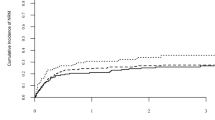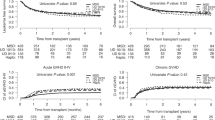Abstract
During the last 10 years, the number of alternative Haematopoietic stem cell transplantations (HSCTs) performed on children in Europe has increased significantly and has reached 61% of the allografts. In this paper, we provide practical guidelines to help define an algorithm for the treatment of children relapsing during or after first-line chemotherapy for ALL and lacking a matched sibling donor. A simultaneous search for an unrelated donor and for a cord blood unit should be started. This study focuses mainly on the effects of some factors on survival in an effort to highlight the influence that these factors have on our choices. Matching the patient for HLA-A, -B, -C and -DRB1 alleles remains the top priority: a single HLA class I or II allele mismatch has no influence on survival, while multiple mismatching for more than one class I allele and simultaneous disparities in class I and II alleles increase mortality. The impact of additional mismatches for HLA-DQ and -DP loci on survival is still controversial. Young donor age is the most important factor that has a significant effect on better survival from among several other factors, including CMV sero-status, gender and ABO. An 18- to 30-year-old, 8/8 allele-matched donor (excluding allele matching at DQB1) or for many teams 10/10 allele-matched donor; or a 4 out of 6 (considering Ag HLA-A, -B and allelic typing of DRB1) CB unit containing more than 3.0 × 107 nuclear cells is considered by most institutions. The choice should be made on the basis of urgency. If a donor or a CB unit is not found within an appropriate time frame, generally less than 3 months after obtention of remission, haploidentical HSCT should be offered. Some institutions consider haploidentical HSCT the second therapeutic option when a matched donor is not available.
This is a preview of subscription content, access via your institution
Access options
Subscribe to this journal
Receive 12 print issues and online access
$259.00 per year
only $21.58 per issue
Buy this article
- Purchase on Springer Link
- Instant access to full article PDF
Prices may be subject to local taxes which are calculated during checkout

Similar content being viewed by others
References
Schrappe M, Reiter A, Zimmermann M, Harbott J, Ludwig WD, Henze G et al. Long-term results of four consecutive trials in childhood ALL performed by the ALL-BFM study group from 1981 to 1995. Berlin–Frankfurt–Munster. Leukemia 2000; 14: 2205–2222.
Rubnitz JE, Pui CH . Recent advances in the treatment and understanding of childhood acute lymphoblastic leukemia. Cancer Treat Rev 2003; 29: 31–44.
Uderzo C, Conter V, Dini G, Locatelli F, Miniero R, Tamaro P . Treatment of childhood acute lymphoblastic leukemia after the first relapse: curative strategies. Haematologica 2001; 86: 1–7.
Badell I, Munoz A, Ortega JJ, Martinez A, Madero L, Bureo E et al. Long-term outcome of allogeneic or autologous haemopoietic cell transplantation for acute lymphoblastic leukaemia in second remission in children. GETMON experience 1983–1998. Bone Marrow Transplant 2005; 35: 895–901.
Matsuzaki A, Nagatoshi Y, Inada H, Nakayama H, Yanai F, Ayukawa H et al. Prognostic factors for relapsed childhood acute lymphoblastic leukemia: impact of allogeneic stem cell transplantation—a report from the Kyushu–Yamaguchi Children's Cancer Study Group. Pediatr Blood Cancer 2005; 45: 111–120.
Davies SM, Wagner JE, Weisdorf DJ, Shu XO, Blazar BR, Enright H et al. Unrelated donor bone marrow transplantation for hematological malignancies––current status. Leuk Lymphoma 1996; 23: 221–226.
Dini G, Valsecchi MG, Micalizzi C, Busca A, Balduzzi A, Arcese W et al. Impact of marrow unrelated donor search duration on outcome of children with acute lymphoblastic leukemia in second remission. Bone Marrow Transplant 2003; 32: 325–331.
Sasazuki T, Juji T, Morishima Y, Kinukawa N, Kashiwabara H, Inoko H et al. Effect of matching of class I HLA alleles on clinical outcome after transplantation of hematopoietic stem cells from an unrelated donor. N Engl J Med 1998; 339: 1177–1193.
Petersdorf EW, Gooley TA, Anasetti C, Martin PJ, Smith AG, Mickelson EM et al. Optimizing outcome after unrelated marrow transplantation by comprehensive matching of HLA class I and II alleles in the donor and recipient. Blood 1998; 92: 3515–3520.
Henslee-Downey PJ, Gluckman E . Allogeneic transplantation from donors other than HLA-identical siblings. Hematol Oncol Clin North Am 1999; 13: 1017–1039.
Rocha V, Cornish J, Sievers EL, Filipovich A, Locatelli F, Peters C et al. Comparison of outcomes of unrelated bone marrow and umbilical cord blood transplants in children with acute leukemia. Blood 2001; 97: 2962–2971.
Locatelli F, Rocha V, Chastang C, Arcese W, Michel G, Abecasis M et al. Factors associated with outcome after cord blood transplantation in children with acute leukemia. Blood 1999; 93: 3662–3671.
Gluckman E, Rocha V . Cord blood transplantation for children with acute leukaemia: a Eurocord registry analysis. Blood Cells Mol Dis 2004; 33: 271–273.
Lazzari L, Corsini C, Curioni C, Lecchi L, Scalamogna M, Rebulla P et al. The Milan Cord Blood Bank and the Italian Cord Blood Network. J Hematother 1996; 5: 117–122.
Klingebiel T, Handgretinger R, Lang P, Bader P, Niethammer D . Haploidentical transplantation for acute lymphoblastic leukemia in childhood. Blood Rev 2004; 18: 181–192.
Handgretinger R, Klingebiel T, Lang P, Schumm P, Neu S, Geiselhart A et al. Allografting megadose transplantation of purified peripheral blood CD34+ progenitor cells from HLA-mismatched parental donors in children. Bone Marrow Transplant 2001; 27: 777–783.
Messina C, Cesaro S, Rondelli R, Rossetti F, Locatelli F, Pession A et al. Autologous bone marrow transplantation for childhood acute lymphoblastic leukaemia in Italy. AIEOP/FONOP-TMO Group. Italian Association of Paediatric Haemato-Oncology. Bone Marrow Transplant 1998; 21: 1015–1021.
Balduzzi A, Gaipa G, Bonanomi S, Dassi M, Perseghin P, Buscemi F et al. Purified autologous grafting in childhood acute lymphoblastic leukemia in second remission: evidence for long-term clinical and molecular remissions. Leukemia 2001; 15: 50–56.
Miano M, Labopin M, Hartmann O, Angelucci E, Cornish J, Gluckman E et al. Haematopoietic stem cell transplantation trends in children over the last three decades: a survey by the paediatric diseases working party of the European Group for Blood and Marrow Transplantation. Bone Marrow Transplant 2007; 39: 89–99.
Schreuder GM, Hurley CK, Marsh SG, Lau M, Maiers M, Kollman C et al. The HLA dictionary 1999: a summary of HLA-A, -B, -C, -DRB1/3/4/5, -DQB1 alleles and their association with serologically-defined HLA-A, -B, -C, -DR, and -DQ antigens. Hum Immunol 1999; 60: 1157–1181.
Beatty PG, Anasetti C, Hansen JA, Longton GM, Sanders JE, Martin PJ et al. Marrow transplantation from unrelated donors for treatment of hematologic malignancies: effect of mismatching for one HLA locus. Blood 1993; 81: 249–253.
Petersdorf EW, Longton GM, Anasetti C, Martin PJ, Mickelson EM, Smith AG et al. The significance of HLA-DRB1 matching on clinical outcome after HLA-A, B, DR identical unrelated donor marrow transplantation. Blood 1995; 86: 1606–1613.
Petersdorf EW, Longton GM, Anasetti C, Mickelson EM, Smith AG, Martin PJ et al. Definition of HLA-DQ as a transplantation antigen. Proc Natl Acad Sci USA 1996; 93: 15358–15363.
Gajewski J, Gjertson D, Cecka M, Tonai R, Przepiorka D, Hunt L et al. The impact of T-cell depletion on the effects of HLA DR beta 1 and DQ beta allele matching in HLA serologically identical unrelated donor bone marrow transplantation. Biol Blood Marrow Transplant 1997; 3: 76–82.
Flomenberg N, Baxter-Lowe LA, Confer D, Fernandez-Vina M, Filipovich A, Horowitz M et al. Impact of HLA class I and class II high-resolution matching on outcomes of unrelated donor bone marrow transplantation: HLA-C mismatching is associated with a strong adverse effect on transplantation outcome. Blood 2004; 104: 1923–1930.
Petersdorf EW, Anasetti C, Martin PJ, Gooley T, Radich J, Malkki M et al. Limits of HLA mismatching in unrelated hematopoietic cell transplantation. Blood 2004; 104: 2976–2980.
Ringden O, Schaffer M, Le Blanc K, Persson U, Hauzenberger D, Abedi MR et al. Which donor should be chosen forhematopoietic stem cell transplantation among unrelated HLA-A, -B, and -DRB1 genomically identical volunteers? Biol Blood Marrow Transplant 2004; 10: 128–134.
Shaw BE, Marsh SG, Mayor NP, Russell NH, Madrigal JA . HLA-DPB1 matching status has significant implications for recipients of unrelated donor stem cell transplants. Blood 2006; 107: 1220–1226.
Petersdorf EW, Gooley T, Malkki M, Horowitz M, for The International Histocompatibility Working Group in Hematopoietic Cell Transplantation. Clinical significance of donor–recipient HLA matching on survival after myeloablative hematopoietic cell transplantation from unrelated donors. Tissue Antigens 2007; 69 (Suppl 1): 25–30.
Ljungman P, Biron P, Bosi A, Cahn JY, Goldstone AH, Gorin NC et al. Cytomegalovirus interstitial pneumonia in autologous bone marrow transplant recipients. Infectious Disease Working Party of the European Group for Bone Marrow Transplantation. Bone Marrow Transplant 1994; 13: 209.
Kollman C, Howe CW, Anasetti C, Antin JH, Davies SM, Filipovich AH et al. Donor characteristics as risk factors in recipients after transplantation of bone marrow from unrelated donors: the effect of donor age. Blood 2001; 98: 2043–2051.
Miller RA . The aging immune system: primer and prospectus. Science 1996; 273: 70–74.
Buckner CD, Clift RA, Sanders JE, Stewart P, Bensinger WI, Doney KC et al. Marrow harvesting from normal donors. Blood 1984; 64: 630–634.
Carlens S, Ringdén O, Remberger M, Lönnqvist B, Hägglund H, Klaesson S et al. Risk factors for chronic graft-versus-host disease after bone marrow transplantation: a retrospective single centre analysis. Bone Marrow Transplant 1998; 22: 755–761.
Benjamin RJ, McGurk S, Ralston MS, Churchill WH, Antin JH . ABO incompatibility as an adverse risk factor for survival after allogeneic bone marrow transplantation. Transfusion 1999; 39: 179–187.
Sierra J, Storer B, Hansen JA, Bjerke JW, Martin PJ, Petersdorf EW et al. Transplantation of marrow cells from unrelated donors for treatment of high-risk acute leukemia: the effect of leukemic burden, donor HLA-matching, and marrow cell dose. Blood 1997; 89: 4226–4235.
Bensinger WI, Buckner CD, Thomas ED, Clift RA . ABO-incompatible marrow transplants. Transplantation 1982; 33: 427–429.
Gluckman E, Rocha V, Arcese W, Michel G, Sanz G, Chan KW et al. Factors associated with outcomes of unrelated cord blood transplant: guidelines for donor choice. Exp Hematol 2004; 32: 397–407.
Gluckman E, Koegler G, Rocha V . Human leukocyte antigen matching in cord blood transplantation. Semin Hematol 2005; 42: 85–90.
Uderzo C, Valsecchi MG, Bacigalupo A, Meloni G, Messina C, Polchi P et al. Treatment of childhood acute lymphoblastic leukemia in second remission with allogeneic bone marrow transplantation and chemotherapy: ten-year experience of the Italian Bone Marrow Transplantation Group and the Italian Pediatric Hematology Oncology Association. J Clin Oncol 1995; 13: 352–358.
Locatelli F, Zecca M, Messina C, Rondelli R, Lanino E, Sacchi N et al. Improvement over time in outcome for children with acute lymphoblastic leukemia in second remission given hematopoietic stem cell transplantation from unrelated donors. Leukemia 2002; 16: 2228–2237.
Hough R, Labopin M, Michel G, Locatelli F, Klingebiel T, Arcese W et al. Outcomes of fully haploidentical hematopoietic stem cell transplantation compared to unrelated cord blood transplantation in children with acute lymphoblastic leukaemia. Bone Marrow Transplant 2007; 39: S3 (abstract).
Eapen M, Rubinstein P, Zhang MJ, Stevens C, Kurtzberg J, Scaradavou A et al. Outcomes of transplantation of unrelated donor umbilical cord blood and bone marrow in children with acute leukaemia: a comparison study. Lancet 2007; 369: 1947–1954.
Rocha V, Gluckman E . Outcomes of transplantation in children with acute leukaemia. Lancet 2007; 369: 1906–1908.
Acknowledgements
We acknowledge Sara Calmanti for her help in preparing the paper. This study has been supported in part by the Italian Ministry of Health, Programma di Ricerca Finalizzata ex articolo 12 D.L.gs 502/92 2005 ‘Assistenza Domiciliare in Bambini ed Adulti affetti da Patologie Emato-Oncologiche’.
Author information
Authors and Affiliations
Consortia
Corresponding author
Additional information
Conflict of interest
None of the authors declared any financial interests.
Rights and permissions
About this article
Cite this article
Lanino, E., Sacchi, N., Peters, C. et al. Strategies of the donor search for children with second CR ALL lacking a matched sibling donor. Bone Marrow Transplant 41 (Suppl 2), S75–S79 (2008). https://doi.org/10.1038/bmt.2008.59
Published:
Issue Date:
DOI: https://doi.org/10.1038/bmt.2008.59



